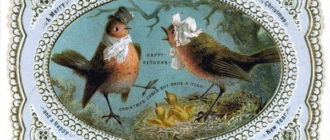
Painting Children running from a thunderstorm by Konstantin Makovsky a meeting that will be remembered for a lifetime
Children Running from the Thunderstorm is a painting by Konstantin Yegorovich Makovsky in 1872. In the center of the composition is a village girl, 9-10 years old, in a bleached homespun shirt and a long sundress. She hurries and carries on her back a little boy about five years old, carefully holding him by the legs. On the belt there is a knot with mushrooms. But she does not think about the collected delicacy. Her anxious eyes and thoughts are directed to the sky, where the clouds of approaching bad weather are gathering.
A gusty wind bends tall steppe grasses to the ground. The handkerchief tied to his head was knocked off by the rapid movement. Ahead is a stream with dark water, covered with marsh duckweed, and sedge thickets along the edges. Barefoot had already stepped onto the rickety makeshift bridge. The viewer involuntarily feels how the old board bent under the weight of children’s bodies. And at the same time he admires the skill of the author, who managed to convey the tension of the moment, to realistically reflect the emotions of children trying to get home before the elements break out.
The title of the painting: Children running from a thunderstorm.
Author: Konstantin Makovsky (1839-1915).
Year of writing: 1872
Dimensions: 167 x 102 cm.
Style: Realism. Romanticism.
Genre: Household. Scenery.
Technique: Oil painting.
Material: Canvas.
Location: State Tretyakov gallery, Moscow
About the artist
Makovsky Konstantin Yegorovich is a Russian itinerant painter, portrait painter, an outstanding master of historical and genre painting of the late 19th century, a vivid adherent of realism and democratic ideals. He traveled a lot in the Russian outback, studied folk types and colors, reflecting his observations in his works. His works, filled with a wealth of colors and craftsmanship, delighted not only the metropolitan public and famous collectors, but also members of the royal family. Depicting even ordinary people, the master departed from the image of the “orphaned and the poor” popular at that time.
He especially liked the bright children’s faces, with a clear, meaningful look. The plot of the painting “Children running from a thunderstorm” was a real incident that took place in the Tambov province. Making sketches of nature, Makovsky attracted the attention of local children. Having surrounded the artist, they looked with interest at the outlandish tools and devices, vying with each other to ask questions. The most lively and inquisitive was one girl with large, not childishly serious eyes.
Painting history
Konstantin Yegorovich offered to paint her portrait. She agreed. But the time appointed for the next day did not come. Her younger brother came running instead. He told the artist the story that became the plot of the picture. It turned out that the day before my sister had gathered in the forest to pick mushrooms. The boy followed her.
On the way back, the children saw an approaching thundercloud and ran home. But the boy did not keep up with his sister. And then she put him on her back. However, crossing the stream, she could not resist on the shaky bridge and fell into the water. The boy flew to the side, onto the grass, and remained dry, but his sister was very wet. At night, she began to have a fever, and by morning she was completely ill.
But remembering the appointment, I sent my brother to the artist. “Children running from a thunderstorm” Konstantin Makovsky finished in St. Petersburg. He wrote from memory, now and then evoking the image of a village girl and the events of that day. The work turned out to be alive and touching, with a touch of sentimental sadness, and took its rightful place in the history of Russian art. And the story, which became the plot, remained in the artist’s memory until the end of his days.






